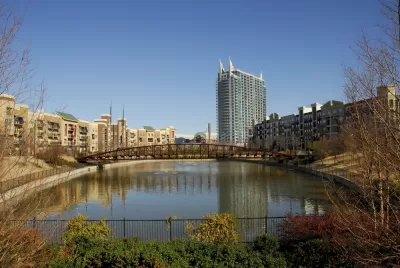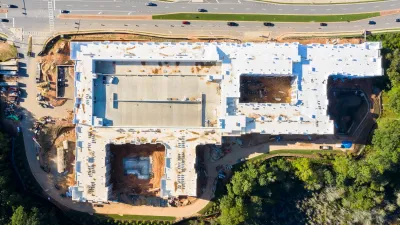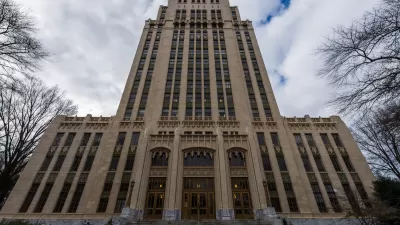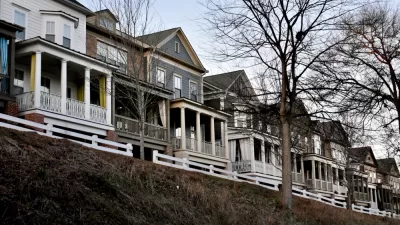Even if new housing is expensive, it can reduce overall housing prices by causing existing units to become more affordable.

While reading the Market Urbanism blog a few weeks ago, I noticed the following comment: “In cities with high rents and exclusivity, developers don't build low-income or affordable housing, they build to maximize their profits. That means simply a greater abundance of unaffordable housing.” In other words, housing prices are whatever developers want them to be: if a developer decides that it feels like charging a million dollars for a condominium, it can wave its Magic Wand of Luxury, and can forever find rich people who will gladly pay a million dollars.
But my own condo-buying experience suggests otherwise. In 2002, I bought a one-bedroom condominium in Atlanta for $133,000. On one hand, Atlanta is not one of the nation’s more expensive cities; on the other hand, my condo is in one of the city’s most affluent areas, Buckhead. The average house or condo value in Buckhead’s zip code is about half a million dollars—lower than in Manhattan, but higher than that of many outer-borough neighborhoods. In short, this is a high-demand zip code.
My condominium was certainly a luxury building when it was built. In addition to the pools and clubhouses common in Atlanta buildings, this building has a 24-hour doorman, a fairly unusual feature in Atlanta. So I would imagine that when my building got its first occupants in 1988, the developer did not think it would be “affordable housing” in any sense of the word.
But then the recession happened. The last time I checked, Zillow.com said that the condo was worth only $94,000, and that if someone bought it, he or she would pay $516 for the mortgage and property taxes (plus condo fees). My condo is certainly far more affordable than I had envisioned, even by Atlanta standards.
What happened? Of course, the recession reduced demand for housing in Atlanta. But according to the National Association of Home Builders, regional housing prices are only about 10 percent below their 2006 peak—far below my unit’s 30 percent drop.
More importantly, there seems to be a lot of newer housing in Buckhead; Zillow lists 126 condos for sale in zip code 30305; almost half of them were built after mine (which was built in 1988), and 45 of them were built after 2000. (By contrast, on New York’s 10023 zip code in the Upper West Side, only 30 of 291 units for sale were built after 1988.) Thus, it appears that Buckhead’s surge of new housing may have held down the price of older units such as mine.
It could be argued that because Atlanta is a low-cost city, its experiences are therefore irrelevant to those of more expensive cities. But in Atlanta, as in New York, new units are luxury units. Of the 45 condos for sale in my zip code built after 2000, not one is as cheap as mine. Only two of the condo units are being offered for less than $200,000 (though seven foreclosed units being put up for auction have lower “Zestimates,” which are Zillow’s guess of their value), and the median price is $375,000. Pre-2000 units are cheaper; five were less expensive than my $94,000 estimate, and ten foreclosures have lower Zestimates. The median price of pre-2000 units was slightly below $200,000. So in both Atlanta and New York, it appears that newer units are more expensive than older units.
It therefore seems to me that the law of supply and demand applies to housing even where new housing is significantly more expensive than older housing. The presence of new units holds down the price of older units by increasing the overall supply of housing and by making the older units less desirable in comparison. It logically follows that if any city builds (or allows the private sector to build) enough new housing, the desirability of new construction should make existing units more affordable. The only difference between a high-demand city and a low-demand city is that the city has to work harder to produce the new housing.

Planetizen Federal Action Tracker
A weekly monitor of how Trump’s orders and actions are impacting planners and planning in America.

Maui's Vacation Rental Debate Turns Ugly
Verbal attacks, misinformation campaigns and fistfights plague a high-stakes debate to convert thousands of vacation rentals into long-term housing.

Restaurant Patios Were a Pandemic Win — Why Were They so Hard to Keep?
Social distancing requirements and changes in travel patterns prompted cities to pilot new uses for street and sidewalk space. Then it got complicated.

In California Battle of Housing vs. Environment, Housing Just Won
A new state law significantly limits the power of CEQA, an environmental review law that served as a powerful tool for blocking new development.

Boulder Eliminates Parking Minimums Citywide
Officials estimate the cost of building a single underground parking space at up to $100,000.

Orange County, Florida Adopts Largest US “Sprawl Repair” Code
The ‘Orange Code’ seeks to rectify decades of sprawl-inducing, car-oriented development.
Urban Design for Planners 1: Software Tools
This six-course series explores essential urban design concepts using open source software and equips planners with the tools they need to participate fully in the urban design process.
Planning for Universal Design
Learn the tools for implementing Universal Design in planning regulations.
Heyer Gruel & Associates PA
JM Goldson LLC
Custer County Colorado
City of Camden Redevelopment Agency
City of Astoria
Transportation Research & Education Center (TREC) at Portland State University
Jefferson Parish Government
Camden Redevelopment Agency
City of Claremont






























